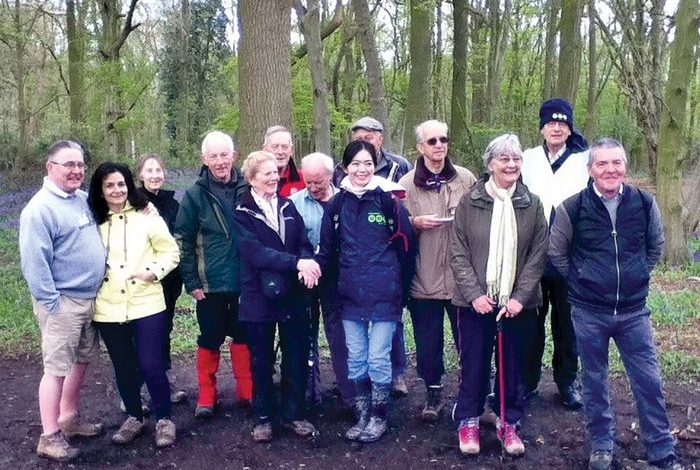Mei Leng, the Ipoh girl who walks with others, to stay healthy


By Mariam Mokhtar
A few years ago, when an opportunity to work in England arose, Ipohite Yau Mei Leng, the Principal IT Consultant in a multinational infrastructure and asset management consulting firm, grabbed it.
In late 2014, Mei Leng decided to exercise everyday and disciplined herself to walk to work. She says, “Almost every day, I walk for about 100 minutes, to cover five miles. Over the past year, I have walked about 1000 miles. I don’t walk when the weather is bad and I am off work.
“I love walking long distances. My friend recommended that I join the ‘Walking for Health’ programme and last March, I volunteered and trained to be a Walk Leader, in my county.”
The pleasure derived from walking has motivated Mei Leng to encourage more people to live a healthier lifestyle. She said, “As a Walk Leader, I help people to get active by leading and supporting health walks. I also act as a frontline ambassador for the Walking for Health programme.”
“I give a brief talk before the walk, and manage joint walks with other walk leaders. I ensure the walks are welcoming, friendly, enjoyable, safe and effective.”
“We may have to deal with problems, on our walks, such as anti-social behaviour, people destroying crops, arguing and nuisance walkers.”
Safety is a top priority, and she said, “My greatest challenge is to manage a large group of walkers. Some of the routes involve crossing roads.”
“Walkers must use the pavement, if there is one, and not spill onto the carriageway. I keep the group together and warn everyone to stay alert and mind the traffic.”
Walks are graded into five categories with the first being the easiest walk. It takes around 20 to 30 minutes, on flat and even ground. According to Mei Leng, walkers proceed at a gentle pace and have regular stops.
The Grade 1 is an easy walk which takes 30 minutes and covers 1.5 miles over gentle hills, whilst the final grade, the Grade 4 walk, takes from 90 to 120 minutes, over steep inclines and stiles.
Mei Leng leads the Grade 4 walks for the Hertfordshire county council and her route cuts across hills, past farms with cows, sheep, alpaca and horses grazing, and through fields with crops such as maize, wheat, rapeseed. Her route passes through Gobions Wood, a nature reserve, where she said walkers can enjoy the green spaces and seasonal wildlife.
She said, “We have either raincoats or sun hats. We walk throughout the year. Walks are only cancelled for safety reasons, if there is very bad weather like blizzards, icy paths or high winds.
“If no-one turns up for a walk, there’s obviously no point in the leaders walking on their own, but if at least one person arrives, and is keen to walk, most schemes will run.”
Mei Leng said that the “Walking for Health” programme is England’s largest network of health walk schemes, helping people lead a more active lifestyle. A survey in December 2012, showed that there were 600 registered schemes, 3400 weekly walks nationwide, 70,000 regular active walkers, and 10,000 volunteers supporting the programme, of whom 9000 were walk leaders.
Most walks are free and open to all age groups as they are designed to increase the fitness of people who are inactive or suffering from a long-term health conditions.
The fitness levels of both new and current walkers are assessed. Walkers must state any health problems and possess both the mental and physical capability to complete the circuit. She said, “If I think the walk is too challenging for someone, I will inform him, and refer him to a lower walking grade.”
Conscious that all walkers are of different age groups and have different progress rates, she said, “I set-off at a slow pace and speed up after five to 10 minutes. At certain points, we slow down and stop to rest, to enable the slow walkers to catch up. We want to keep walkers motivated and confident to complete the circuit.
“In Hertfordshire, where I lead, the majority are pensioners above 55 with a history of strokes, knee injuries, diabetes and other age-related illnesses. Occasionally, people in their 20s, 30s and 40s join us. At other times, parents bring their children for walks, and some walkers bring their dogs along, to exercise.”


“We also watched sheep being herded by a sheepdog. At one time, our path was blocked by four cows. The cows refused to move and it took us some time, to persuade them to proceed! It was a hilarious moment.
Obeying the walk leaders instructions is important. Although nothing bad has happened on her walks, Mei Leng described the experiences of another walk leader, who has had several mishaps.
A stubborn walker refused to listen to a warning about grass-covered rabbit holes. She said, “Rabbit holes are deep. The walker deliberately put his foot into a rabbit hole, for fun, and broke his leg. A few months later, he repeated his folly, and broke his foot again.”
When asked if Malaysians could be encouraged to walk more often, Mei Leng said, “Walking is the simplest form of exercise. It is free, sociable and anyone can do it at his own pace.
“Regular walking can significantly improve a person’s health, well-being and confidence. Since I started walking, on a daily basis, my muscles, bones and breathing have become stronger.”
Mei Leng said that few Malaysians are keen on walking because of the scorching heat and various safety reasons. She said that Malaysians, who want to start walking to become healthier can set up similar programmes, in their local area, develop safe walking routes and choose suitable walking hours, such as early morning or late evening.
She said, “The walking programme could be made more enjoyable and sociable by describing the history of the route. People can walk and sing, or watch the wildlife.”
She has one confession. “I was not a fan of walking, when I lived in Malaysia. I only developed my interest in walking since I moved to England.”


